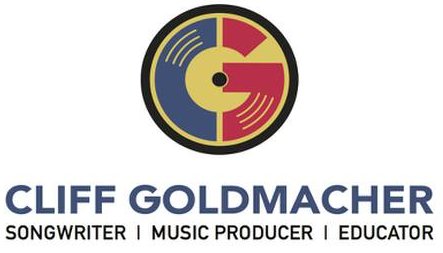https://www.musical-u.com/learn/4-ways-spice-scales/
Scales can be a real sore spot for musicians but they don’t have to be. There are a variety of ways you can make scales more interesting to practice. This can let you get the benefit of scales practice – without the boredom! https://www.musical-u.com/learn/4-ways-spice-scales/
The Music Business: What’s Changed, What’s Stayed the Same, with Cliff Goldmacher
These days everyone is an expert. Just slap something up on the internet, and if it looks good, everyone will trust that you know what you’re talking about. Right? Well, if that’s the case, how do you know that the “expert” advice on your songwriting and songwriting career is really going to help?
The answer is to find someone who’s been around, and who moves with the times. Someone like Cliff Goldmacher – a Nashville industry insider with a 1000 + song catalog who’s collaborated with the likes of Keb’ Mo’, Ke$ha, Lisa Loeb, and Mickey Hart.
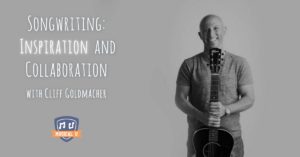 Last time we spoke, Cliff offered a fascinating view into his professional songwriting and collaboration process. Then – since Cliff has thrived through 25 + years of extraordinarily rapid change in the industry – we wanted to know more about what it takes to be in the music business today.
Last time we spoke, Cliff offered a fascinating view into his professional songwriting and collaboration process. Then – since Cliff has thrived through 25 + years of extraordinarily rapid change in the industry – we wanted to know more about what it takes to be in the music business today.
I initially found you and started learning about you was from a blog that you wrote talking about how talent, raw talent, is not enough to make it in this industry. So many of us look at the Kurt Cobain’s of the world and the Lady Gaga’s and just these incredibly talented artists, and we think, “We can never do that.” But you’ve talked about the necessity of hard work and just how much is required to make it happen.
I look at this like a sliding scale: there’s talent and there’s work ethic.
Where it’s all talent and no work, you have to be at the super-duper genius level. This rarely works. Where it’s all work and no talent – this rarely works either. But anything in between starts to work pretty well.
If your work ethic at least matches your talent level, you’ve given yourself an opportunity.

Now, you don’t have to be Kurt Cobain, you don’t have to be Lady Gaga – you have to have talent. At some point talent becomes the least common denominator.
Last time we talked about that second-year hump in Nashville. One of the things that made that second-year mark in Nashville so daunting, for me, was the realization of how many people had talent. Like, all of a sudden I realized, “Oh. Oh wow. All right. If talent becomes the least common denominator, how am I going to set myself apart now?” Like, if I don’t have the kind of talent that just makes people say “Well, it’s a no brainer.”
And by the way, for every Kurt Cobain, there are thousands and thousands and thousands of artists who don’t have that kind of talent, but with the right amount of effort can have a career. Whether it’s at his level, that only has partly to do with your talent and your work ethic. That’s also the planets lining up.
Q: All that being considered, what would you recommend some of the top skills that musicians need to develop to succeed in this industry?
 As far as skill set, it starts with this mindset: if you want people to pay for it, you have to think of it as a job. It’s not just, “I’m really good at this thing so the world is going come find me.” You have to work for this.
As far as skill set, it starts with this mindset: if you want people to pay for it, you have to think of it as a job. It’s not just, “I’m really good at this thing so the world is going come find me.” You have to work for this.
I saw a quote the other day that I absolutely loved: “A lot of people don’t recognize opportunity because it comes disguised as hard work.” And it’s a lot of work. It’s not romantic work. There is nothing romantic about figuring out people to send your songs to. Nothing romantic about that. Romantic is writing the song, and that’s a great motivator. That’s the part that gets you up out of bed in the morning, but the other stuff is what keeps the lights on. You’ve got to do both.
Q: Yes. Definitely. Being in Nashville when you first started out – an incredibly dense environment full of incredible musicians – but now with the digital age, social media, all sorts of different ways to reach people, some would argue that the music industry has become flatter, more accessible to everyday musicians. Are there any hidden opportunities within this ecosphere that people just don’t know about yet that you see coming?
An attorney friend of mine used this big fancy term and I love it: disintermediation. In other words, it went from the record labels as the ones that made all the decisions about what the public at large heard. Then all of a sudden, with the advent of social media and the internet, the playing field became completely leveled.
Anybody, now, can write a song and the next day have it available for worldwide distribution. That’s a miracle, but the noise level has gone up infinitely.
The opportunities utilize the same sort of old fashioned skill sets like marketing, like hard work – the opportunities are there for the people who aren’t just throwing their music out there and hoping it will stick.
Like, figuring out some sort of an angle and doing a video. I’m thinking of an example that comes to mind immediately: OK Go became famous not because their songs are good, which they are, but because their videos are these miraculously elaborate things where they’re on and off treadmills or doing human size Rube Goldberg machines and things like that.
They found a way to rise above the noise not just with their music, but with their marketing.
In a large part that is what has to happen now since everybody has the opportunity to get their music out to a wider audience.
Cutting through the noise. Definitely an end result of the democratization of media. It’s been an amazing journey. I feel like we’re just at the beginning of it still. That being in mind, you talk about how much it’s changed since you first got into this industry.
Yeah.
Q: Outside of the marketing side and the digital side, what else have you noticed that’s changed in the music industry and how can a songwriter take advantage of these changes?
Well, you’re reminding me of something – now, it’s not enough to try and get a song on an artist’s album, right? Because albums are starting to almost fade into obscurity. Now, you have to have the song that they release as a single or nothing – no one will ever hear it…
Those other songs don’t go along for the ride anymore because people can download or stream individual songs, right? Do you know what that’s like? That’s like the 45s from the 1950s.

Singles of the Past: 45 RPM Records
On one level, brand new model. On another level, there’s nothing new under the sun.
I bring that up because it’s extremely important to remember at the end of the day there are certain things that will always apply. What will always apply is hard work. What will always apply is figuring out a way to market or find an angle for your style of music, what it is you’re doing.
The way that things have probably most obviously changed is that the income streams have broadened and lowered. There are many more ways that you can make money for your songs now. If you get a song on YouTube and it has a million views and there are advertisers, you’re getting paid a piece of that action. Or that you get an album of yours on Pandora and it starts to get some spins. With SoundExchange, which is the company that monitors that and pays out songwriters, all of a sudden you’re making income there too. That’s great.
The problem is mechanicals, meaning the actual physical sales of CDs or cassettes or vinyls – all of that has dropped dramatically. So there are many, many more opportunities to sell your music and all of them pay much, much less. That’s probably the biggest change that I see at this point.
But I’m pretty much an inveterate optimist. I feel like this stuff is gonna shake itself out. Right now, you hear a lot of people screaming, there’s a lot of wringing of hands about the fact a song is played a million times on Spotify the guy gets eight cents or whatever the case may be. I’m not saying this is a problem, but this is also not set in stone.
I work on the board of an organization called NARAS, which is the National Academy of Recording Artists and Sciences, and they are the ones who are in D.C. lobbying for improved copyright law and for better rates for streaming. They’re also the folks that do the Grammys. This is a big organization. In the same way that movie people thank “The Academy”, this is “The Academy” for music. I can tell you that there are a lot of very committed people doing a lot of hard work to improve this scenario, but it’s slow going and people need to be educated.
For young songwriters thinking about doing this, still first and foremost, do it because you love it. Do it because you love it, and, second of all, don’t despair. There are good people working hard to make sure that this resolves itself in a reasonable way.
Q: That’s hopeful news and great advice for the up and coming songwriter. So many people see “the industry” as the enemy, and it’s cool to hear from an insider like yourself that the music industry is adapting, changing, and trying to help the artists earn more money for their efforts.
But before even considering a music career, how do songwriters know if they have “what it takes”?
If you are moved to write songs if you are moved to do what you are doing, I don’t care who tells you they don’t like it, I don’t care whether you hear that more than you hear anything else. If you love what you’re doing and feel like you’re improving and you’re being true to your vision, then what it really takes is willing to continue to do this in the face of all that (at the worst) criticism – but more commonly, apathy.
I wrote songs for 15 years before a major label artist recorded one of my songs. That’s a really, really, really long time to wait before the industry says to me, “Hey, we think you’re ready.” Now, I knew personally how much I had improved from the time I moved to Nashville or wrote my first song, to the time that I got that song recorded by an artist on a major label.
I knew in my heart that I was improving, but it’s really hard to tell someone at a cocktail party what that means when you’ve got nothing to show for it, in the eyes of the larger world. Really, what it takes, if you want to know the truth – and this is where I’m going to sound like a broken record – you just have to keep working. If you are willing to work in the face of that kind of slow process or downright discouragement, then you have what it takes.
Q: That’s very inspiring. Thank you. Do have any final thoughts for our audience? Anything you’d like to share?
I keep coming back to this too, but it’s just so important. And I’ve mentioned this in some talks that I’ve done, and it’s a little bit crass. But I think it really drives the point home: writing songs only for the money is like getting married only for the sex.
What I mean by that is, essentially, “Look. If you do make money, that’s great.” And we all have that as a goal. I’m not going to lie to you – I have to make a living at this too. But the thing that gets me out of bed in the morning and the thing that makes me so excited when I’ve written new songs is that I love writing songs.
It’s not that I wrote something and I think, “Oh good, there’s my rent for next month.” I don’t look at it that way, and maybe I should, but I don’t think like that.
So if there’s any piece of advice I would leave your listeners with is you better be doing this because you love it.
Q: Great. Yes. Love what you do and do what you love.
Yep.
Great advice! And that love is what propels so much of us in the music industry to not only pick up that instrument in the first place, but to dedicate all those hours in the practice room learning theory and everything else.
That’s exactly it.
Wonderful, Cliff. It’s good to know that the fundamental wisdom of doing what you love still reigns, even in though the music industry keeps changing. Thank you so much for bringing aspiring musicians the view from “the other side”.
The more things change…
The music business continues in its current state of rapid change and innovation. But the commitment to doing what you love, hard work in both the music and business sides of the equation, and old-fashioned marketing savvy remain the core of a successful musician’s skill set – putting the opportunity – and responsibility – squarely in your court.
Are you ready to take charge of your songwriting career? Whether it is songwriting tips and in-depth learning, music business insider instruction, or state of the art streaming online recording studio services, let Cliff Goldmacher help you move forward in your passion.
The post The Music Business: What’s Changed, What’s Stayed the Same, with Cliff Goldmacher appeared first on Musical U.
We live in a very interesting time. Let’s take a look int…
https://www.musical-u.com/learn/the-sound-of-new-indie-music/
We live in a very interesting time. Let’s take a look into what goes into contemporary music production today, where the scene came from, which techniques are being implemented and what has become part of the arsenal of a modern day music warrior.https://www.musical-u.com/learn/the-sound-of-new-indie-music/
The Ultimate Guide to the Circle of Fifths
New musicality video:
The Circle of Fifths is a mystery to many. But what if you found everything you ever needed to know and learn about musical pitch (every note, scale, chord, progressions, etc.) in a simple diagram that could fit in the palm of your hand?
https://www.musical-u.com/learn/how-to-use-circle-fifths
The Circle of Fifths is that magical musical master tool.
This learning device has endured for hundreds of years since its invention, and for good reason; there’s no need to reinvent the wheel. Or, apparently, any other circular entity.
“But is it for me?”, you may ask.
Though the Circle of Fifths is most commonly understood as a component of classical music theory, it’s certainly not only for the hallowed halls of the conservatory. It’s a valuable tool for any musician of any musical background.
Our guide is the Circle of Fifths made easy – very little prior musical knowledge is required, but by the end of this article, you’ll not only understand the mechanics behind the circle, but also how to apply it in music theory, transposition, singing, songwriting, and more.
This incredibly powerful tool will take you far beyond simply understanding music theory – it will help you write music, predict chords in a progression, and understand relationships between major and minor keys. It will serve you well, regardless of whether you are a classical violinist, jazz saxophone player, a bassist in a rock band, or aspiring DJ.
So fasten your seatbelt: we’re diving deep into this infinite pool of musical wisdom. As you will soon see, the magical mojo of this Ring of Power surpasses even Tolkien’s imagination!
https://www.musical-u.com/learn/how-to-use-circle-fifths
===============================================
Learn more about Musical U!
Website:
https://www.musical-u.com/
Tone Deaf Test:
http://tonedeaftest.com/
Musicality Checklist:
https://www.musical-u.com/mcl-musicality-checklist
Facebook:
https://www.facebook.com/MusicalU
Twitter:
Tweets by MusicalU
YouTube:
https://www.youtube.com/c/MusicalU
Subscribe for more videos from Musical U!
A Wheel That Needs No Reinvention: the Circle of Fifths
Far from merely being a component of music theory, the Circle of Fifths is the key to unlocking the mysteries of Western music. With just one easy-to-memorize diagram, you’ll not only be able to recall keys and key signatures, but also utilize this knowledge to transpose music, write impactful chord progressions, and compose melodies.
What Exactly is the Circle of Fifths?
The Circle of Fifths is a tool that you can carry around with you in your back pocket, or even in the back of your brain.
It’s one of those rare musical tools that is equally helpful for understanding theoryandfor applying it to practice and songwriting.
The all-in-one diagram gives you every major key, along with its key signature and relative minor, so you can gather the basic information of the key you’re playing in just by glancing at it.
Beginnings of the Circle
The Circle of Fifths has been around for a long time, though it didn’t always look like the diagram we know and love today. In the late 1670’s, Russian composer and music theorist Nikolay Diletsky wrote Grammatika, a guide to music composition with music theory in mind.
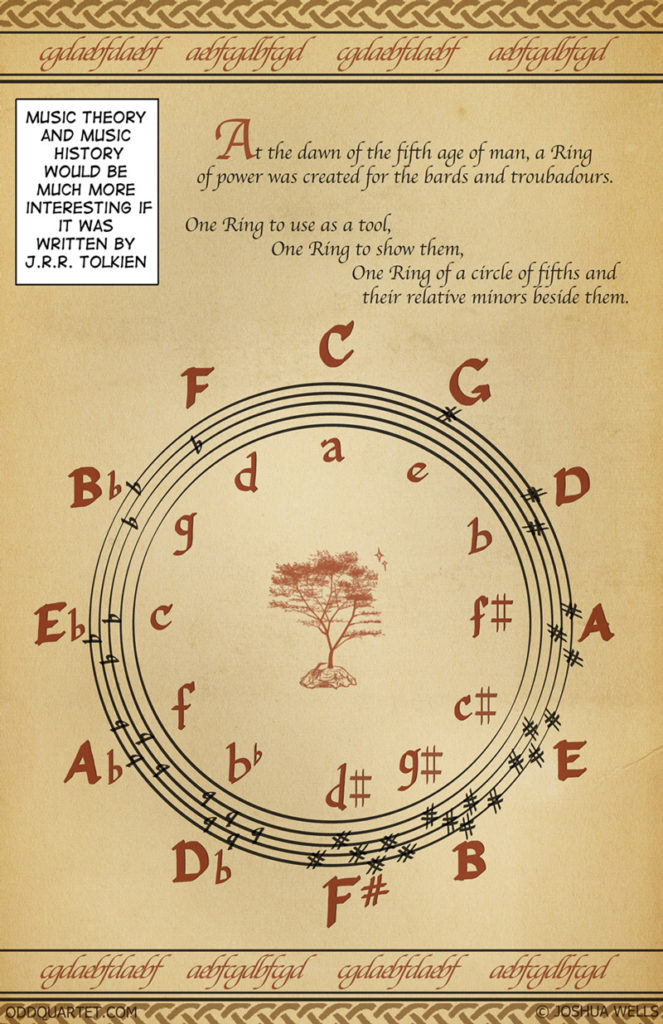
Included in his work was a rudimentary Circle of Fifths. Evidently, enough musicians and theorists caught on to its brilliance that it stuck around. With many revisions and expansions, we got the circle as we know it today.
The Building Blocks of the Circle: Keys and Fifths
Before we dive right into the Circle, let’s look at the key concepts underlying it; the two most central to understanding the circle are keys and fifths.
Keys
Every piece of music has a tonal center, a note that the music naturally resolves to. This note is given the name of the tonic, and is given the scale designation I. Another name for this tonal center is the key.
Each key will have its own key signature, a series of sharps or flats that helps maintain the quality of the key (major or minor). The key signature ensures that the tone/semitone pattern is consistent across all keys of the same quality.
For example, all major keys will have the pattern tone-tone-semitone-tone-tone-tone-semitone, no matter which note they start on!
Fifths
So if we have the tonal center, or the tonic as the first scale degree (I), we have seven scale degrees in total.
The fifth scale degree (V) is perhaps the second-most important one, after the tonic.

The tonic and the fifth, when played together, are referred to as a perfect fifth interval, or simply a perfect fifth. Without going into complicated physics, the basic reason it’s so “perfect” is because the interval vibrates at a pure mathematical ratio, creating a pleasant, consonant sound.
The fifth of any key can also be found by counting seven semitones up from the tonic.
The Components of the Circle of Fifths
Now that we understand keys and fifths, we’re ready to take a look at the basic circle:
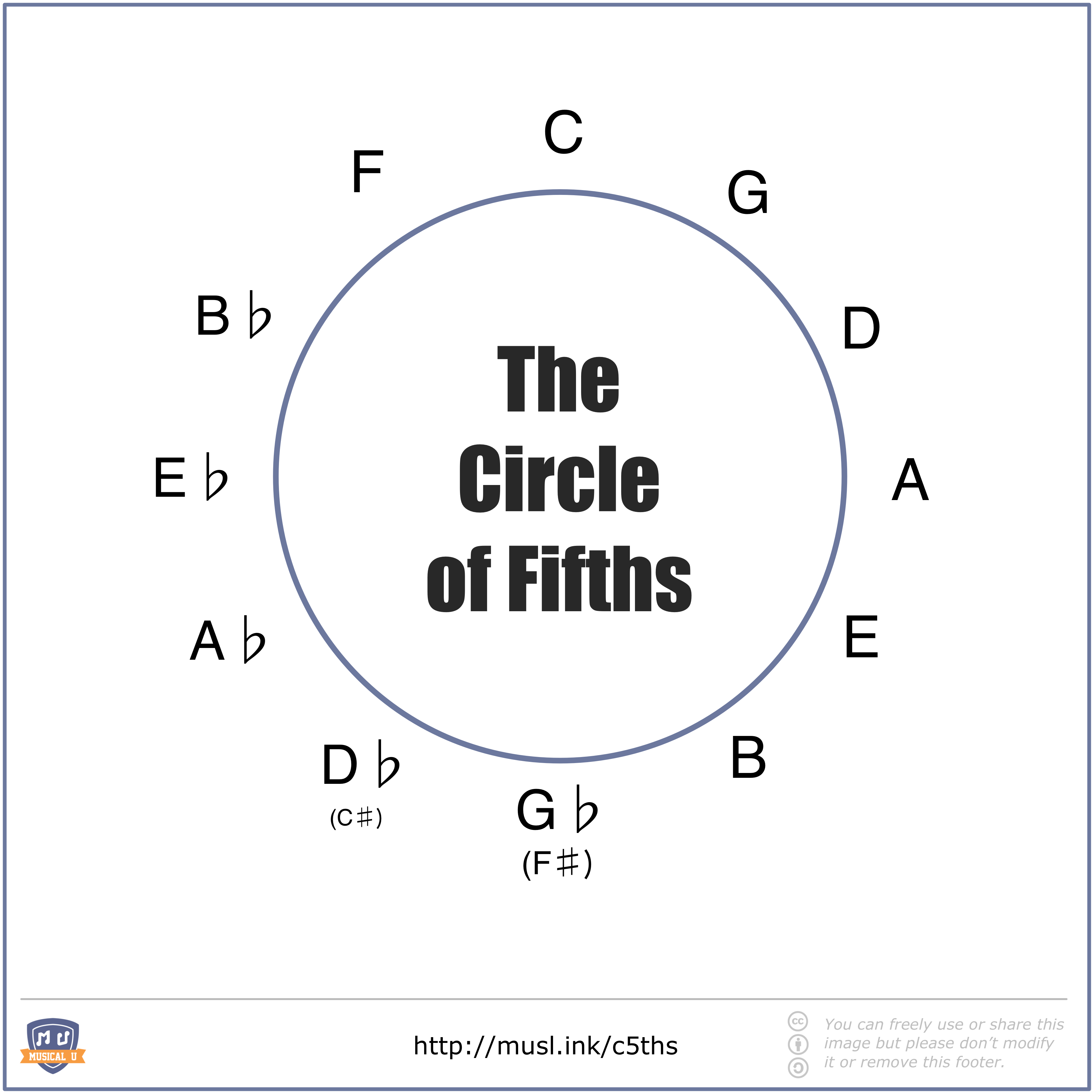
The circle is in fact built on perfect fifth intervals! We start with C major at “12 o’clock”, with each step clockwise being a perfect fifth above the previous note.
In fact, each station on the circle is a note and a key!
Key Signatures
Let’s add another layer to the circle:
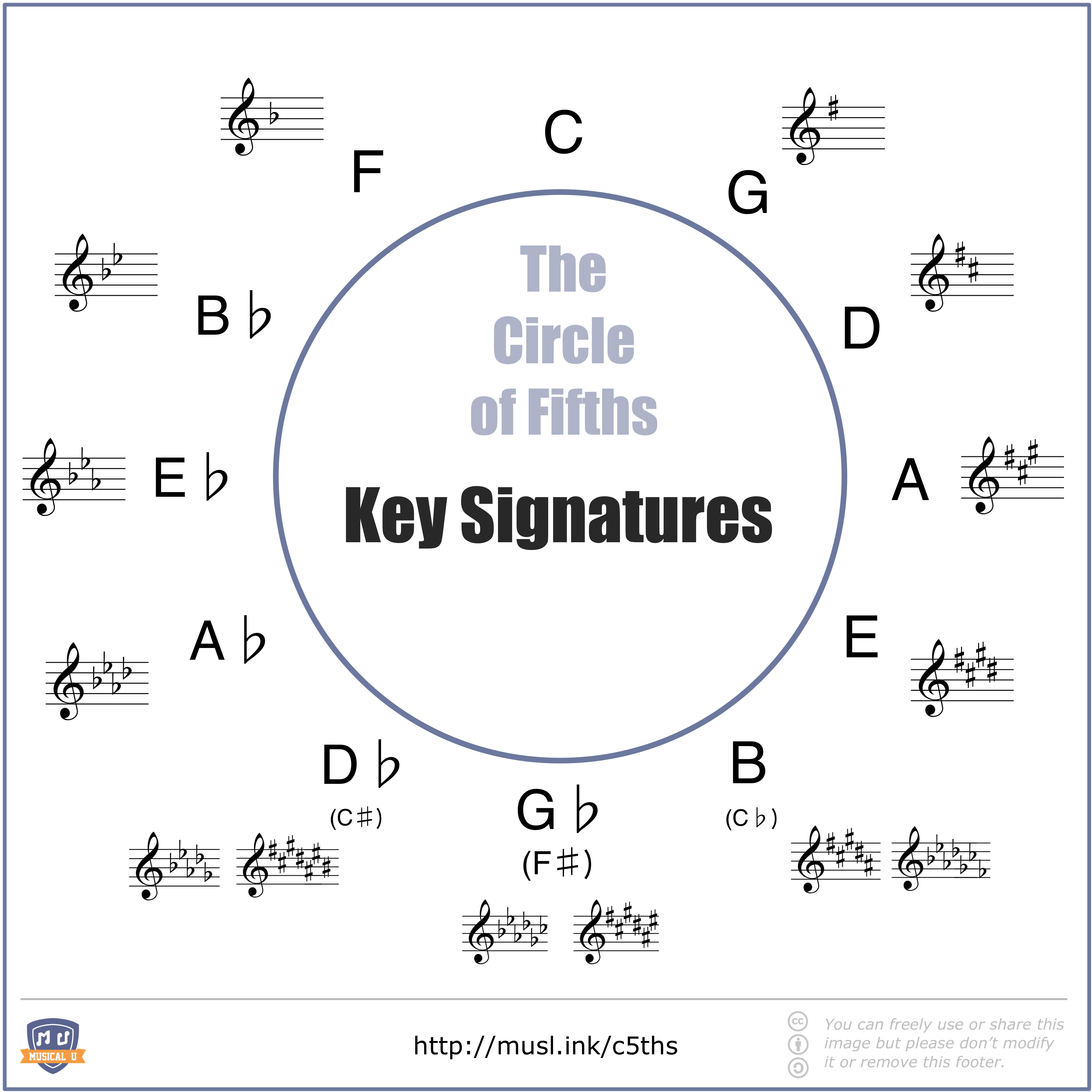
This gives you the major keys with their respective key signatures. Take a look; starting at C major and going clockwise, each new key has one new sharp added to it. Go counterclockwise and it’s the same, just with flats!
It looks a bit crazy, but there’s a repeating pattern to it: simply memorize the sequence F-C-G-D-A-E-B. This gives you the order in which sharps are added clockwise. Reverse this sequence to B-E-A-D-G-C-F, and you get the order in which flats are added counterclockwise.
The number of steps you take around the circle, starting at C, will tell you how many sharps or flats the key will have.
Let’s try an example by figuring out B major’s key signature.
We look at the circle and see that B major is five steps clockwise from C major, so we know we are adding sharps. Look to the F-C-G-D-A-E-B sequence to determine that B major has F#, C#, G#, D#, and A#.
Relative Minors
Now that we have the major keys and their key signatures, let’s add in the final layer: relative minors!
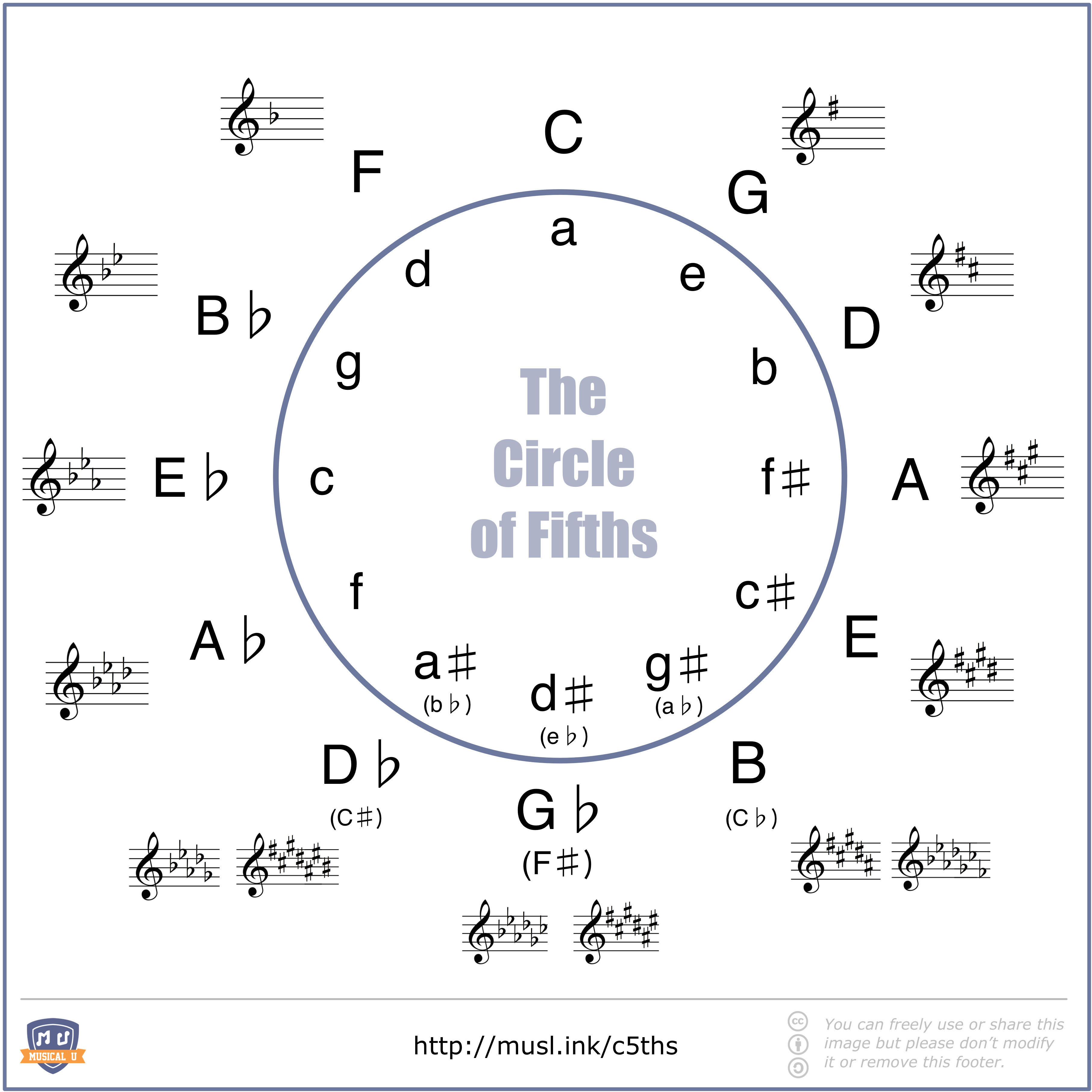
The good news is, this is perhaps the easiest part; most of the work has already been done for you.
The relative minor of a major key will be the 6th degree of the major scale, or three semitones down from the tonic of the major key. If you don’t feel like whipping out a keyboard or writing out scales, the circle itself can help you find all the relative minors – it practically builds itself!
Simply move three steps clockwise from the major key to find the key of the relative minor. Let’s try an example what’s the relative minor of G major?
Head three steps clockwise from G major, and you get to E. The relative minor of G major is therefore E minor.
Relative minors have the same key signatures as their parent major key, and therefore all the same notes. Also, if you’ve been paying close attention, you’ll notice that the relative minors going around the circle clockwise are also a fifth apart!
Using the Circle of Fifths
Once you have the major keys, minor keys, and key signatures that make up the circle, you’re ready to put it to good use.
In fact, you’ve already been clued into two of its uses – spotting the relative minor and key signature of any key at a glance!
Beyond the obvious, the circle has countless uses that become apparent upon closer inspection.
Building Chords with the Circle
Chords are merely clusters of notes that sound pleasant and make sense together.
We’ll focus on the most popular ones here – major, minor, and dominant seventh chords.
Major and Minor Chords
These simply consist of a root note, a perfect fifth above the root, and either a major third (for major chords) or a minor third (for minor chords).
The circle all but gives you the answer; find the fifth by counting one step clockwise on the circle. As for the third, simply count up four semitones from the tonic to find a major third, and three semitones from the tonic to find a minor third.
If you don’t want to count semitones to find your third, the circle is here to rescue you yet again! In a major chord, the major third note will be found four steps clockwise from the tonic. For example, the major third above F will be A:
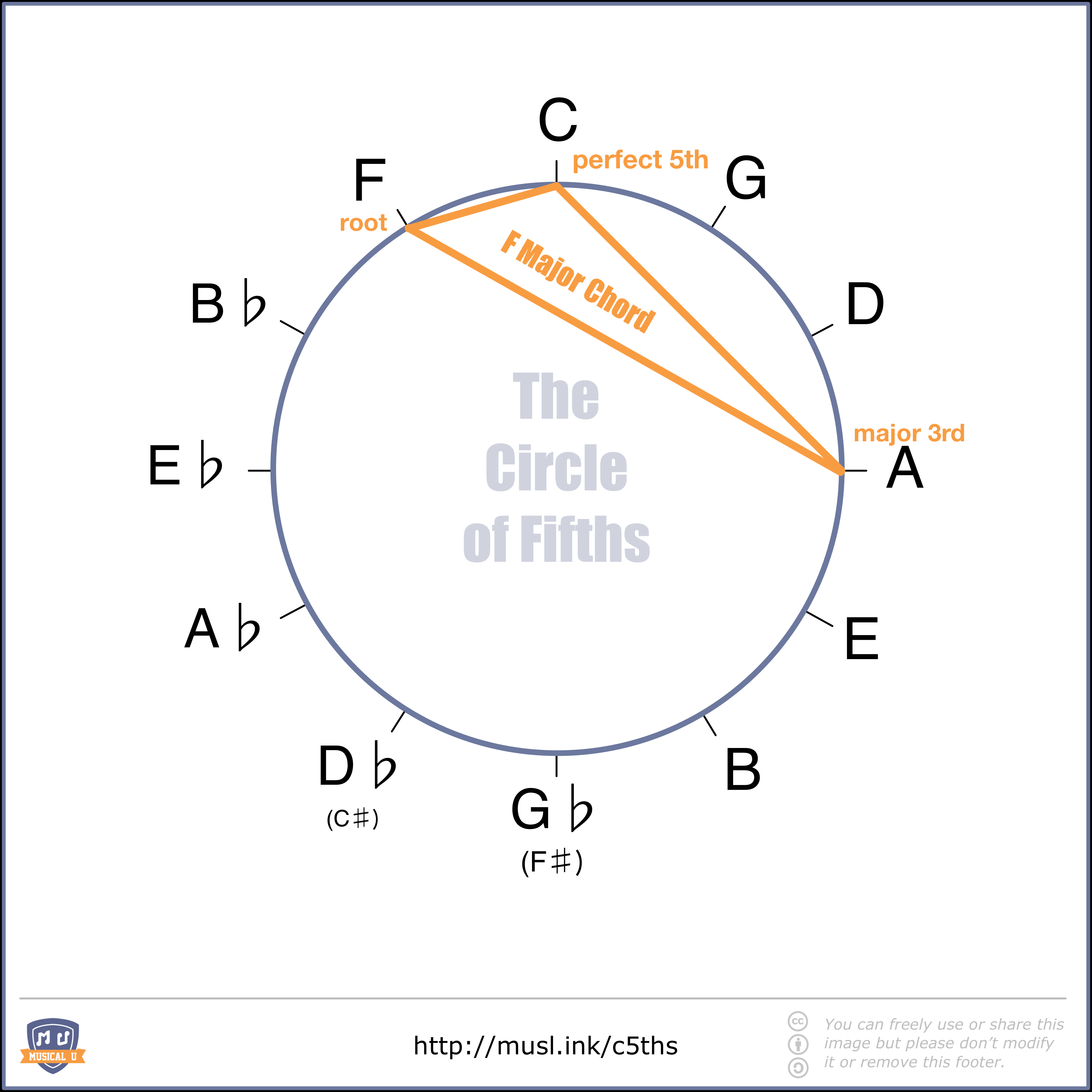
As for a minor chord, the minor third will be found three steps counterclockwise from the tonic note. For example, a C minor chord’s middle note will be E♭:
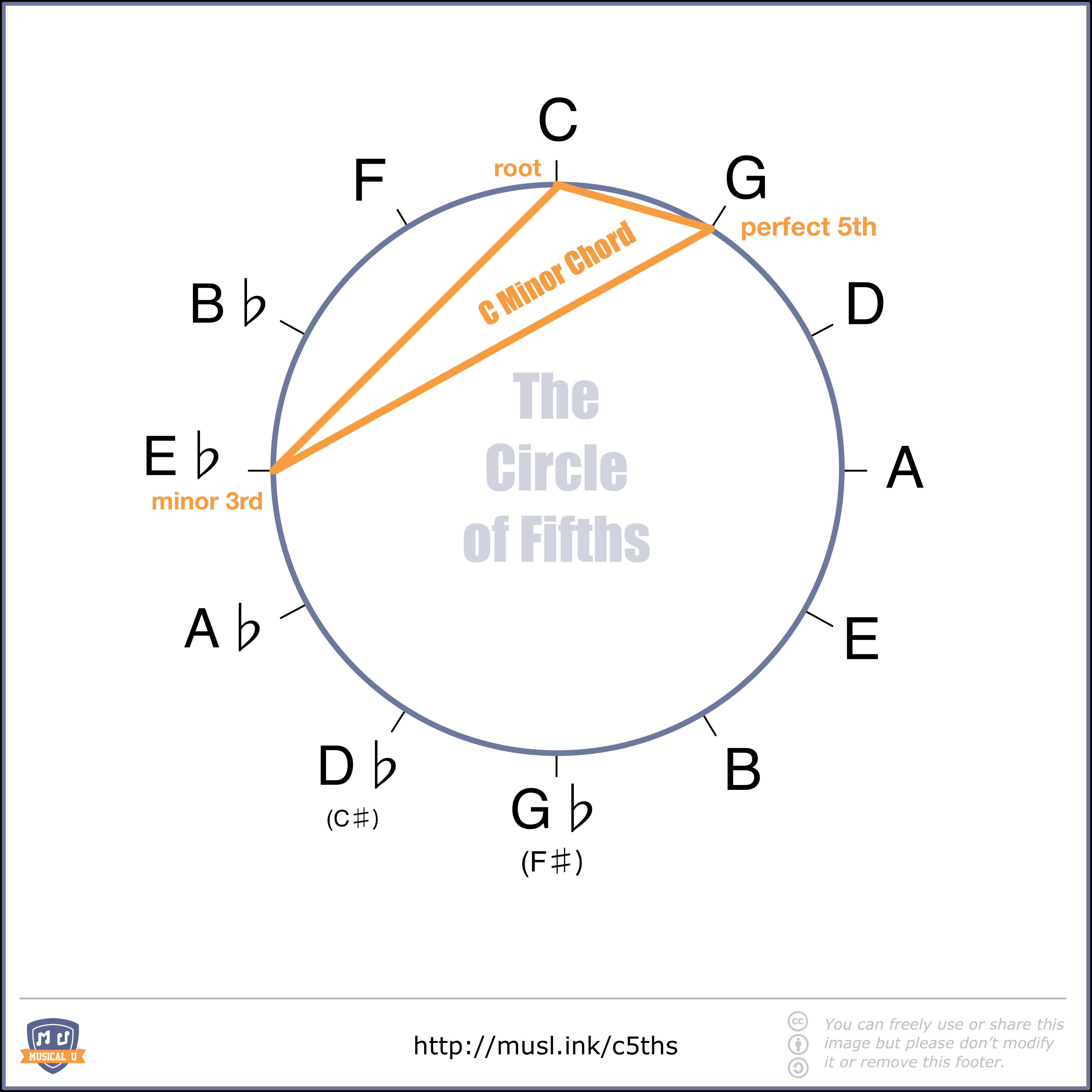
Dominant Seventh Chords
These chords are ubiquitous in popular music. They create a rich, full sound that works particularly well in jazz music.
They’re also easy to build, with the help of the circle! The dominant seventh chord is simply a major chord with a minor seventh stacked on top.
Build your major triad as you normally would. As for the seventh, watch as the circle comes to your aid again! Simply count two steps counterclockwise from the key in which you’re building the chord.
Try this yourself! Build a dominant seventh chord in F# major, and check out the diagram below to see if you got it!
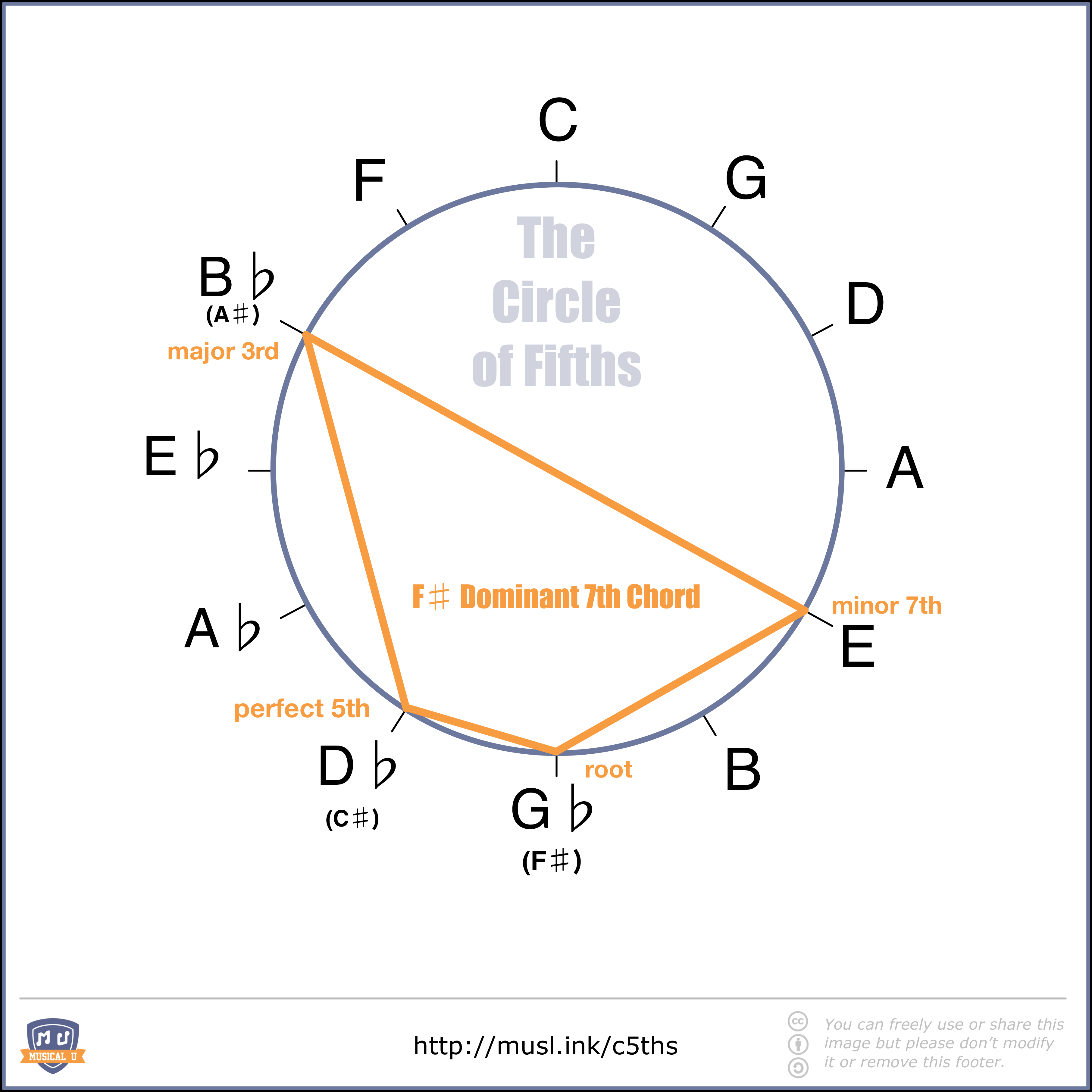
Using the Circle to Play a Simple Chord Progression
A refresher: the most important note in any key is the tonic. It’s the tonal center of the music, the step that the melody will naturally resolve to.
The second-most important chords in a key are the subdominant (IV) and dominant (V). In fact, an amazing number of popular songs make use of the I – IV – V chord progression!
The circle all but shows you how to find this chord progression in any key. Pick any key as your starting point, your tonic. The subdominant (IV) will be found one step counterclockwise to the tonic, while the dominant (V) will be found one step clockwise. For example, if B major is your tonic, E is your subdominant (IV), and F# is your dominant (V).
You can now build your I, IV, and V chords, also using the circle. From there, go ahead and play around with those chords – you’ll be surprised with how many amazing tunes you can build with just those three!
The Circle of Fifths for Songwriters
Beyond simple chord progressions, the circle has a sneaky way of telling you which chords work together, helping you build chord progressions and melodies.
As a general rule, chords that are close together on the circle will sound good in a progression. Why? Because of the order in which they’re arranged, and the fact that accidentals are added stepwise, each key shares 6/7 of its notes with both its neighbours!
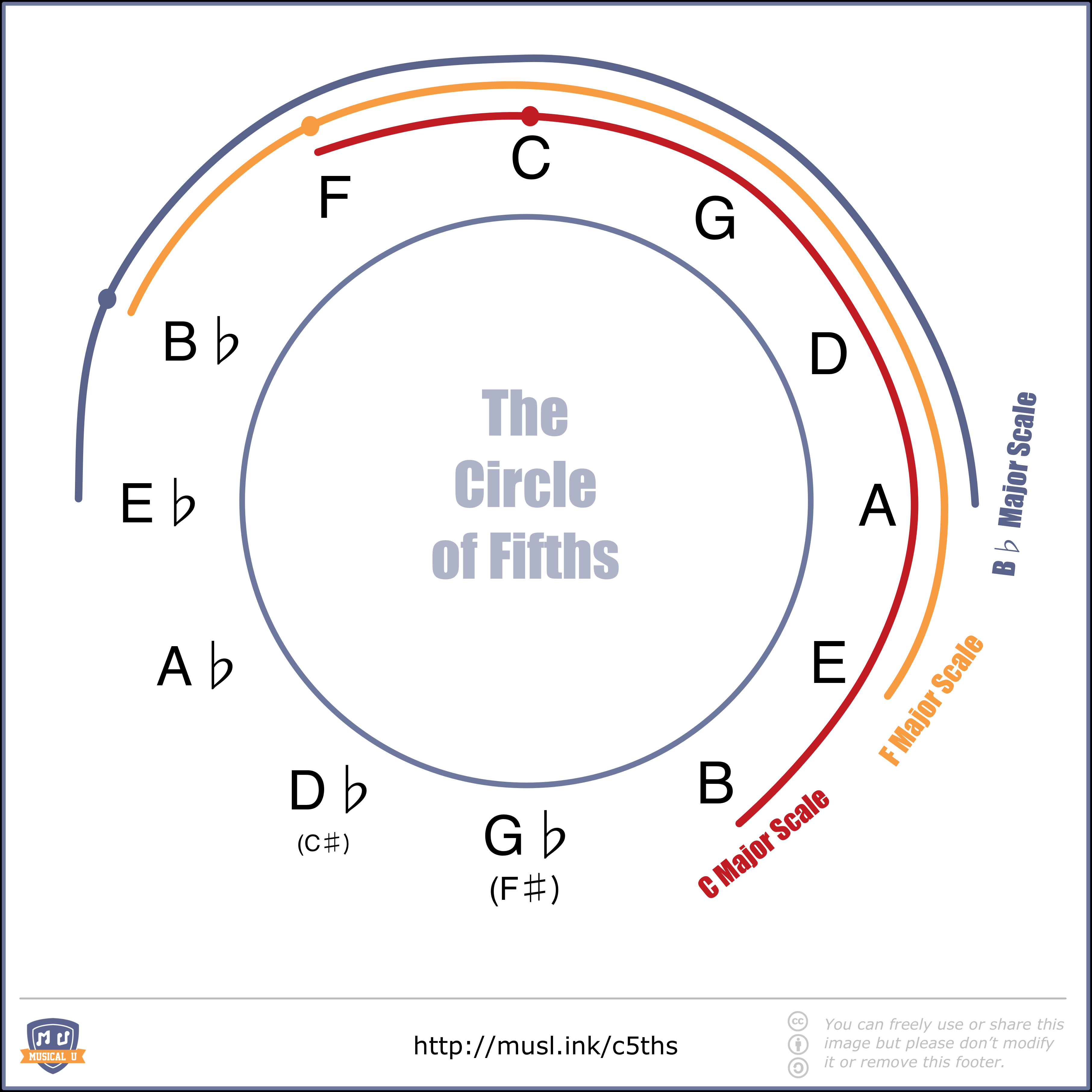
Try building a chord progression that moves around the circle from one “station” to the next; you’ll find that the progression will sound pleasant and consonant, and that you can easily write a melody on top of it.
For something with a little more edge, or some dissonance, try leaping across the circle to a less-related key! You can use this for dramatic effect, to signal a shift-in-gears in the music. You can always find your way back to your tonic after, by continuing your path around the circle.
Jump into the Circle!
It takes some memorization and understanding, but once you understand the mechanics and applications of the Circle of Fifths, it equips you with both theoretical knowledge and compositional ideas.
Before you know it, you’ll start seeing your own patterns in the circle; cheats and tricks to help you see the relationships between notes, chords, and keys.
Now that you’re armed to the teeth with the mechanics and applications of the Circle of Fifths, print (or draw out!) your own version, and experiment with creating your own melodies and chord progressions!
Identifying the tonic note in minor keys consists of reco…
https://www.musical-u.com/learn/finding-tonic-in-minor-keys/
Identifying the tonic note in minor keys consists of recognising the key in minor, and using the notes of the melody and harmony along with certain “clues” to identify the tonic note. It’s important to know about common minor-key cadences to help you tune your ear into the role of the tonic in these harmonies. https://www.musical-u.com/learn/finding-tonic-in-minor-keys/
Do you love music? Are you learning to play music? Whatev…
https://www.musical-u.com/learn/10-musical-ear-training-tips-for-the-adult-beginner/
Do you love music? Are you learning to play music? Whatever age you are, your musicality will benefit from ear training. If you’ve only just picked up an instrument as an adult beginning to learn music, you might be surprised to find out that everyday activities like singing in the shower are the first steps in training your ears… https://www.musical-u.com/learn/10-musical-ear-training-tips-for-the-adult-beginner/
You might not have noticed yet, but music production thes…
https://www.musical-u.com/learn/voice-is-the-new-synthesizer-of-choice-for-producers/
You might not have noticed yet, but music production these days is becoming more and more reliant on digital technology and a Do It Yourself approach. There are several reasons for that: perhaps the most important one is the accessibility of tools formerly only available to the chosen few. https://www.musical-u.com/learn/voice-is-the-new-synthesizer-of-choice-for-producers/
Have you ever struggled with wondering if you truly have …
https://www.musical-u.com/learn/5-surprising-ways-to-become-more-musical/
Have you ever struggled with wondering if you truly have what it takes to become a great musician? If you’ve asked how to become better at music you’ve probably heard the same advice time and time again. But what if there’s another way? https://www.musical-u.com/learn/5-surprising-ways-to-become-more-musical/
Can you imagine listening to a piece of music and knowing…
https://www.musical-u.com/learn/applying-solfa-to-real-music/
Can you imagine listening to a piece of music and knowing exactly what notes you’re hearing? And what that would do for your ability to play what you hear on your instrument? Solfa is a magical key that unlocks the pitches and harmonies in all the music you hear. https://www.musical-u.com/learn/applying-solfa-to-real-music/
